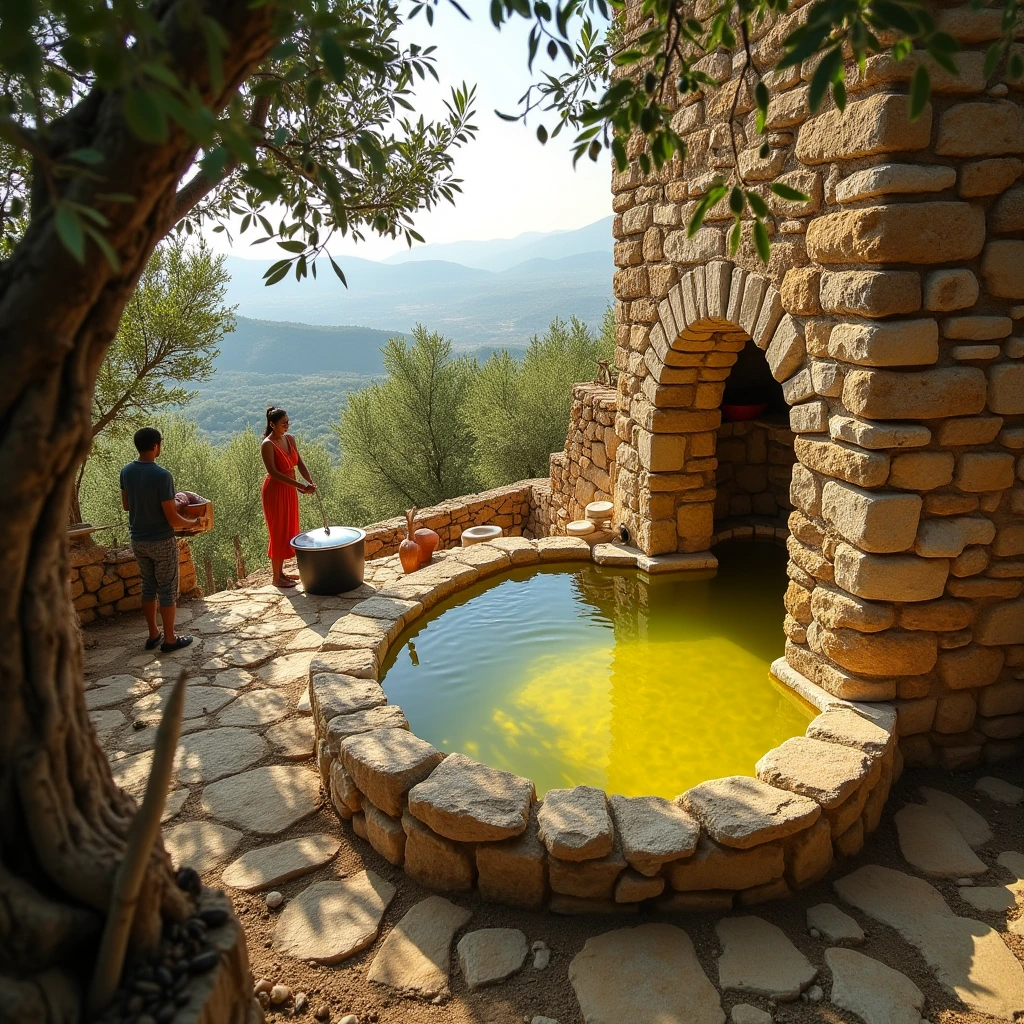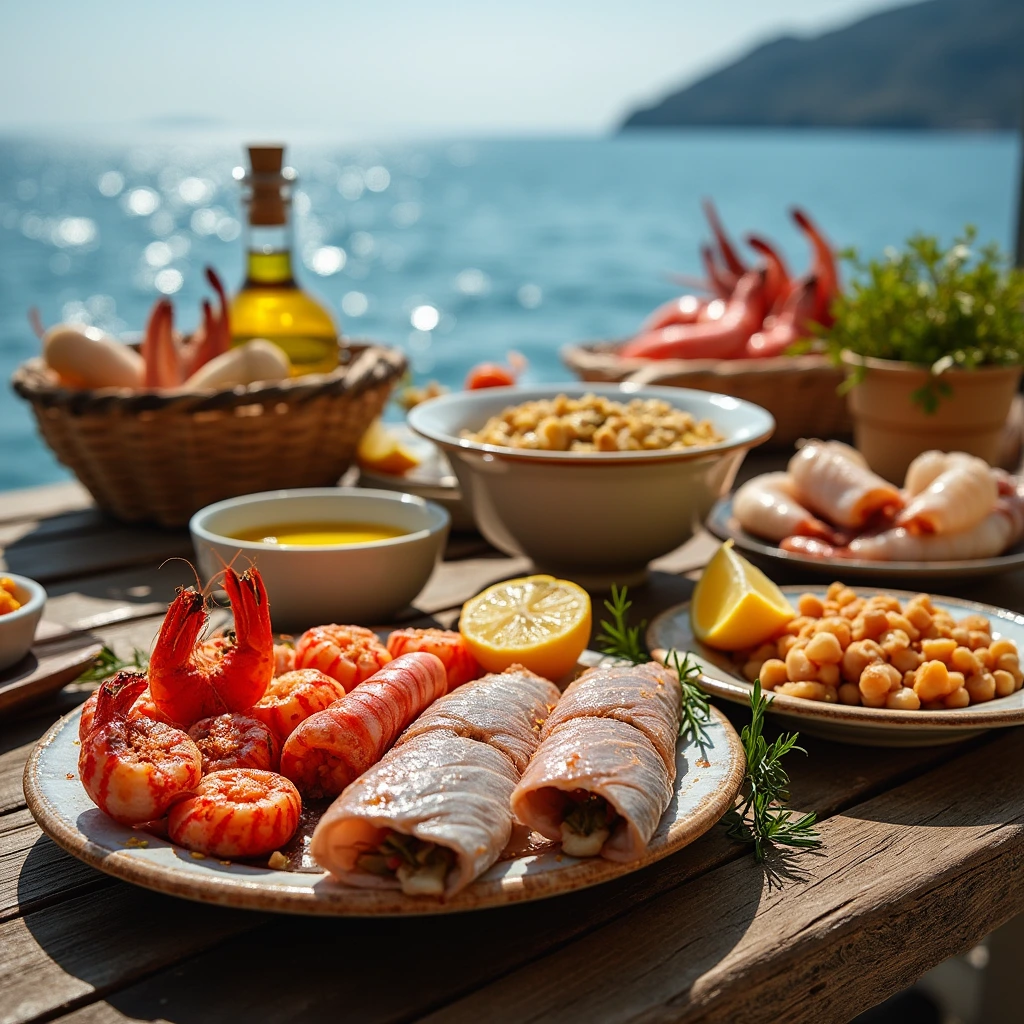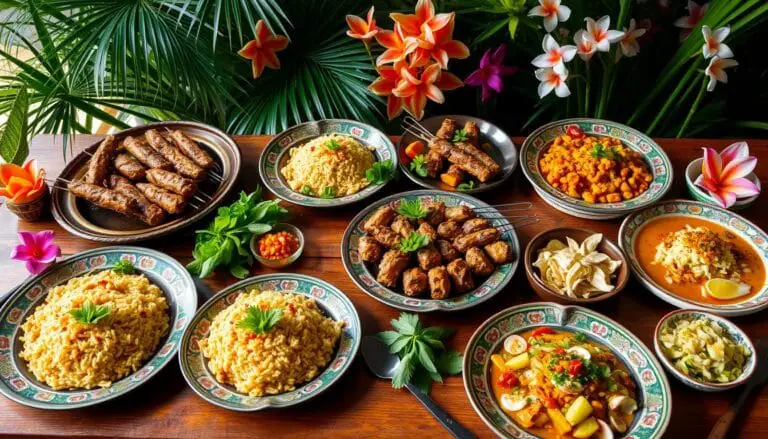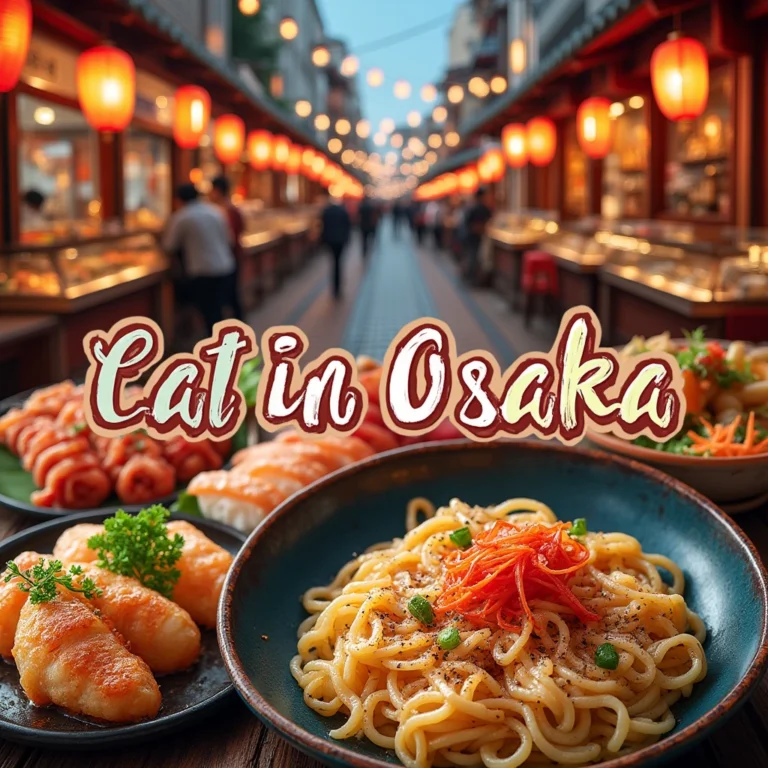Delight in the Soul of Crete: Authentic Greek Flavors Await
This site contains affiliate links . At no additional cost to you, I may receive a commission off these links. They help fund this blog. Thanks for your support! See my Disclosure Policy for more info.
As I step onto the sun-kissed shores of Crete, I’m immediately transported into a culinary wonderland. The scent of freshly pressed olive oil and the sizzle of grilled meats mingle in the air. This captivating Greek island, the largest in the country, is renowned for its traditional cuisine.
Cretan cuisine is more than just a collection of recipes. It’s a tapestry woven with the threads of history, geography, and the island’s deep-rooted connection to the land. The dishes that emerge from Crete’s kitchens reflect the island’s Mediterranean heritage. They celebrate the abundant local ingredients and the enduring power of simplicity.
Table of Contents
Introduction to Cretan Culinary Heritage
Cretan cuisine is a treasure trove of flavors, rooted in ancient Minoan times. The island’s Cretan food history and culinary traditions have grown over millennia. They reflect the unique geography, climate, and cultural influences of Greek island cuisine.
Olive oil, fresh veggies, herbs, and lean proteins are key in Cretan cooking. Recipes and cooking methods have been passed down through generations. They keep the authentic flavors and techniques alive.
Cretan food is more than just food; it’s a way of life. It emphasizes communal dining and warm hospitality. The island’s varied landscapes, from mountains to coastlines, have shaped its cuisine.
The Cretan culinary heritage shows the island’s dedication to quality and sustainability. It celebrates local ingredients. Exploring Cretan cuisine, you’ll find a blend of past and present. It offers a truly authentic and immersive dining experience.
The Foundations of Crete Food
Crete’s food culture is rich and varied. It’s based on Cretan ingredients, cooking techniques, and seasonal eating patterns. The island’s food is made with local produce, traditional cooking methods, and respect for the seasons.
Essential Local Ingredients
The heart of Cretan food is its Cretan ingredients. You’ll find everything from olive oil to fresh vegetables and herbs. The island’s terroir gives Crete’s food its unique taste.
Cretans use goat, lamb, and cheeses in their cooking. These ingredients add to the island’s distinct flavors.
Traditional Cooking Methods
Cretan cooks stick to cooking techniques that honor their heritage. They slow-cook, grill, and use clay pots. These methods bring out the true flavors of the ingredients.
These traditional ways of cooking connect Cretans to their cultural roots. It’s a way to keep their culinary traditions alive.
Seasonal Eating Patterns
Seasonal produce is key to the Cretan diet. Cretans eat with the seasons, using fresh fruits, vegetables, and ingredients. This approach makes each dish special, showing off the island’s variety all year.
By focusing on Cretan ingredients, cooking techniques, and seasonal produce, Crete has a cuisine that’s both traditional and modern. It’s a true reflection of the island’s history and its ever-changing tastes.
| Cretan Ingredient | Description |
|---|---|
| Olive Oil | A cornerstone of Cretan cuisine, Cretan olive oil is renowned for its rich flavor and health benefits. |
| Wild Greens | Cretans forage for a variety of wild greens, such as horta and stamnagathi, which add depth and nutrition to their dishes. |
| Herbs | Fragrant herbs like oregano, thyme, and rosemary are essential in Cretan cooking, imparting bold flavors to both savory and sweet preparations. |
| Goat and Lamb | Meat consumption is limited in Cretan cuisine, but when used, goat and lamb are the proteins of choice, often slow-cooked to perfection. |
| Cheeses | Crete is renowned for its diverse array of artisanal cheeses, including feta, graviera, and anthotyro, which feature prominently in many Cretan dishes. |
Iconic Cretan Appetizers and Salads
Crete, the idyllic Greek island, is famous for its vibrant food culture. Its appetizers and salads are a big part of this. One iconic dish is dakos, a salad with barley rusks, tomatoes, feta cheese, and olive oil.
Cretan cuisine also has many traditional appetizers, or meze. These small dishes use local herbs, olive oil, and seasonal ingredients. Chochlioi, or snails, are a favorite, enjoyed in different ways to highlight their flavor.
| Cretan Meze Dish | Key Ingredients | Approximate Cost |
|---|---|---|
| Dakos salad | Barley rusks, tomatoes, feta cheese, olive oil, red onions, Kalamata olives, capers, oregano, basil | Under €8 |
| Chochlioi (snails) | Snails, olive oil, lemon, herbs | €7 to €10 |
| Cheese-based meze | Myzithra, Graviera, Anthotyros, Kefalotyri cheeses | €4 to €8 per dish |
| Vegetable-based meze | Seasonal greens, staka (Cretan cream sauce) | €5 to €8 per dish |
Whether you’re enjoying the famous dakos salad or trying various Cretan meze, these dishes are a great way to start exploring Crete’s food heritage.
The Art of Cretan Olive Oil Production

Cretan olive oil is famous for its top-notch quality. It’s a key part of the local food scene. Crete has ancient olive trees, some over a thousand years old. The old ways of picking and making the olives give the oil its special taste.
Ancient Olive Groves
Olive trees have been around in Crete since ancient times. They were first seen during the Neolithic era and the Minoan times. Now, a quarter of Crete is covered in olive groves, home to some of the oldest trees.
The Olive Tree of Vouves is a famous tree. It’s between 3,000 and 5,000 years old. It’s huge, with a diameter of 4.6 meters and a circumference of 12.5 meters.
Harvesting and Processing
Even though Crete has modernized its olive oil making, the old ways are still kept alive. Many producers stick to the traditional methods. This helps make Cretan olive oil so special.
The olives are mostly pressed using hydraulic presses. This ensures the oil is of the highest quality, known as Extra Virgin Olive Oil (EVOO).
Health Benefits and Uses
Cretan olive oil, especially from the Koroneiki variety, is known for its freshness and taste. It’s full of vitamin E and good fats. It’s good for your heart because it lowers bad cholesterol.
It’s used in cooking, as a dip, and in traditional medicine. This makes it a big part of Cretan food and culture.
Traditional Meat Dishes and Cooking Methods
Cretan cuisine is famous for its tasty meat dishes. The island loves lamb and goat, cooked in special ways. Antikristo is a key method, where meat is slow-cooked on a spit over an open fire. This makes the meat tender and full of flavor.
Other must-try dishes include apaki, a smoked pork treat. There are also hearty stews and roasts. These dishes use local herbs and spices, adding to their rich taste.
- Antikristo: Slow-roasted meat cooked around an open fire on a circular spit
- Apaki: Smoked pork, a beloved Cretan delicacy
- Stews and Roasts: Comforting and flavorful meat-based dishes
The traditional Cretan diet usually includes meat dishes featuring local lamb, chicken, or pork.
Cretan meat dishes highlight the island’s cooking skills and love for fresh, local ingredients. These recipes and methods have been passed down for generations. They are a big part of Crete’s lively food culture.
When you try Crete’s food, make sure to enjoy these traditional meat dishes. Each one shows the island’s lasting love for good food.
Seafood Specialties of the Island

Crete, the largest Greek island, is famous for its beautiful coastline and rich sea history. Though its food isn’t all about seafood, the coast has many tasty dishes. These dishes highlight the freshness and taste of the Mediterranean.
Coastal Fishing Traditions
For generations, Cretan villages have kept up with traditional fishing. Fishermen use old methods like net fishing and line fishing. This way, the seafood on Cretan plates is not only fresh but also caught responsibly.
Popular Fish Preparations
Cretan seafood dishes let the fish’s natural flavors stand out. You’ll often see grilled whole fish like scorpionfish or red mullet on menus. Octopus dishes, with their soft texture and salty taste, are also favorites. They’re often served with olive oil and lemon.
Local Shellfish Delicacies
- Cretan calamari is loved for its mild, sweet, and salty taste. It’s cooked in many ways, like fried, grilled, or stuffed.
- Many coastal restaurants serve fresh mussels and clams, showing off the Aegean Sea’s bounty.
- The island’s special location and climate make its sea urchin harvests stand out. They’re known for their creamy, salty flavor.
Whether you’re enjoying a simple grilled fish or a big seafood meal, Crete’s coast offers a unique taste of the Mediterranean. It’s a true experience of the sea’s traditions.
Cretan Cheese and Dairy Products
Crete, the largest Greek island, is famous for its Cretan cheeses and dairy products. These treasures come from the island’s rich farming history and old ways of making food.
Graviera is a hard, salty cheese often made from sheep or goat’s milk. Anthotyro is a soft, fresh cheese with a light taste. Mizithra, like ricotta, is a key ingredient in many Cretan dishes.
Crete also has many other traditional dairy products. Staka, a creamy cheese from sheep’s milk, is a special treat in Cretan food.
| Cretan Cheese | Description |
|---|---|
| Graviera | A hard, salty, and buttery cheese often made from sheep or goat’s milk. |
| Anthotyro | A soft, fresh cheese with a delicate flavor. |
| Mizithra | A versatile cheese similar to ricotta, used in many traditional Cretan dishes. |
| Staka | A rich and creamy cheese made from sheep’s milk, a unique Cretan delicacy. |
Dairy is key in Cretan food, enjoyed as part of meze or in famous dishes. The island’s food culture shows the lasting traditions and farming skills that have shaped its flavors.
Traditional Bread and Pastries
Cretan cuisine is famous for its wide range of baked goods. From Cretan bread to traditional pastries and sweet specialties, there’s something for everyone. Bread is a big part of the Cretan diet. Locals make it using grains grown locally.
Rustic Bread Making
The Greek village bread, or horiatiko psomi, is a favorite in Crete. It’s baked in wood-fired ovens, giving it a special taste and texture. The recipe uses simple ingredients like flour, yeast, olive oil, and salt.
Sweet Pastry Varieties
- Kalitsounia: These Cretan cheese pies are loved for their flaky dough and fresh cheese filling.
- Xerotigana: These dough pastries are crispy and sweet, topped with thyme honey.
- Baklava: A Mediterranean favorite, Crete’s version is filled with nuts and honey.
Festival Specialties
Many traditional pastries in Crete are tied to local festivals. They show the island’s rich culture. For example, kourabiedes (almond cookies) are enjoyed at Christmas, while galaktoboureko (custard pie) is a hit during Carnival.
| Pastry | Unique Feature | Occasion |
|---|---|---|
| Kourabiedes | Made with Metaxa brandy, mastika, or ouzo | Christmas |
| Galaktoboureko | Consumed until Carnival | Carnival |
| Mastiha Ice Cream | Features mastic resin from the island of Chios | Year-round |
Cretan cuisine is a testament to the island’s rich cultural heritage, with its traditional bread and pastries reflecting the ingenuity and resourcefulness of the local people.
Local Wines and Spirits
Crete is known for its vibrant wine scene. It produces unique wines from local grapes. The island’s varied soil gives its Cretan wines special flavors. You’ll find Vidiano, Kotsifali, and Liatiko among the favorites.
Crete is also famous for raki, a grape spirit. It’s a sign of welcome when shared after meals. The traditional spirits of Crete show the island’s deep culinary roots.
| Cretan Wine Varieties | Characteristics |
|---|---|
| Vidiano | Crisp, aromatic white wine |
| Kotsifali | Full-bodied red wine |
| Liatiko | Luscious, fruity red wine |
Wine has been part of Crete’s culture for centuries. Today, over 220,000 hectares of grapes are grown. In the past, Cretan Malvasia was a prized export, with huge shipments from Candia.
Now, the Wines of Crete network includes 36 wineries. They focus on local grapes like Vilana and Vidiano. This highlights Crete’s rich wine heritage.
Crete’s wine and spirit traditions are deeply woven into the fabric of its rich culinary heritage, offering a taste of the island’s unique terroir and cultural identity.
Regional Cooking Variations
Crete, the biggest Greek island, has a rich food scene. It shows off the island’s culture. The four regions – Chania, Rethymno, Heraklion, and Lasithi – each has its own special dishes and ways of cooking.
In the mountains, meat dishes are a big deal. Antikristo is a slow-cooking method that makes lamb or goat very tasty. Near the sea, people love fresh seafood from the Mediterranean.
- Chania is famous for its food and local ingredients. Try bougatsa, a pastry with creamy mizithra cheese and sugar or cinnamon.
- Rethymno is known for its wine. The Agia Triada Monastery is a great place for wine tasting.
- In Heraklion, you’ll find graviera cheese and soft pichtogalo Chanion and myzithra cheeses. These cheeses are key in many traditional dishes.
- Lasithi is known for its wide range of local specialties and traditional recipes. Each dish shows off the region’s unique taste.
Cretan food is all about using what’s available. You’ll find lots of olive oil, herbs, and seasonal produce. This makes Cretan food a rich mix of flavors and traditions.
| Region | Culinary Specialties | Unique Characteristics |
|---|---|---|
| Chania | Bougatsa, Mizithra Cheese | Renowned for traditional cuisine and locally sourced ingredients |
| Rethymno | Agia Triada Monastery Wine Tasting | Vineyards are a ubiquitous feature of the landscape |
| Heraklion | Graviera Cheese, Pichtogalo Chanion, Myzithra | Home to the island’s capital and diverse dairy products |
| Lasithi | Diverse Array of Local Specialties | Showcases the region’s distinct culinary identity |
Crete’s food shows its deep connection to the land and people. From mountains to coast, each area offers a taste of Cretan regional cuisine. Visitors get to enjoy the island’s amazing flavors.
Conclusion
Cretan cuisine is a mix of tradition, health, and taste, making it a standout in the Mediterranean. The island’s Cretan food culture has drawn food lovers from around the world. It offers a special dining experience with fresh, local ingredients and old cooking ways.
Crete is a top spot for culinary tourism, showing off its real food heritage. You can find everything from traditional tavernas to new takes on old dishes. The island’s focus on sustainable food and unique flavors has made it the European Region of Gastronomy 2026. This boosts its fame as a key place for Mediterranean gastronomy.
Exploring Crete’s food scene is an adventure you won’t forget. You’ll taste the rich flavors of Cretan olive oil, enjoy the island’s famous dairy, and discover a variety of wild greens and seasonal produce. This journey connects you with the island’s culture and nature, showing you the value of its culinary traditions.
Check Out These Posts:
- Top French Dishes in Paris: Best Meals for Foodies
- Savor Madrid’s Top Dishes: A Feast for Your Senses
- Discover the Best Food Tour of Venice with Locals
FAQ
What makes Cretan cuisine unique?
Cretan cuisine is special because of its history and use of fresh, local ingredients. It shows the island’s rich culture. The food focuses on olive oil, vegetables, herbs, and lean proteins, following the Mediterranean diet.
What are some of the key ingredients in Cretan cooking?
Cretan cooking uses olive oil, wild greens, herbs, and fresh veggies. It also includes snails, goat and lamb, cheeses, and seasonal fruits and veggies. The island’s terroir adds unique flavors to its wines and olive oils.
What are some of the traditional Cretan appetizers and salads?
Traditional Cretan dishes include dakos (barley rusks with tomatoes, cheese, and olive oil) and chochlioi (snails). There are also cheese-based meze dishes. These often feature local herbs, olive oil, and seasonal ingredients.
How important is olive oil in Cretan cuisine?
Olive oil is key in Cretan cuisine. The island has ancient olive groves. Traditional methods make the oil exceptional and healthy. It’s used in cooking, as a condiment, and in remedies.
What are some of the traditional meat dishes in Cretan cuisine?
Meat is important in Cretan cuisine, especially lamb and goat. Traditional dishes include antikristo (slow-cooked meat) and apaki (smoked pork). Stews and roasts often use local herbs and spices.
How does Cretan cuisine differ from other Greek regional cuisines?
Cretan cuisine shares ingredients and techniques with other Greek cuisines. But, Crete’s four regions have their own specialties. These include cheese, meat, and local herbs and veggies.
What role do Cretan wines and spirits play in the island’s food culture?
Crete’s wine industry is thriving, with unique wines from indigenous grapes. Raki, a grape spirit, is a big part of the island’s culture. The island’s terroir makes its wines and spirits distinct.













